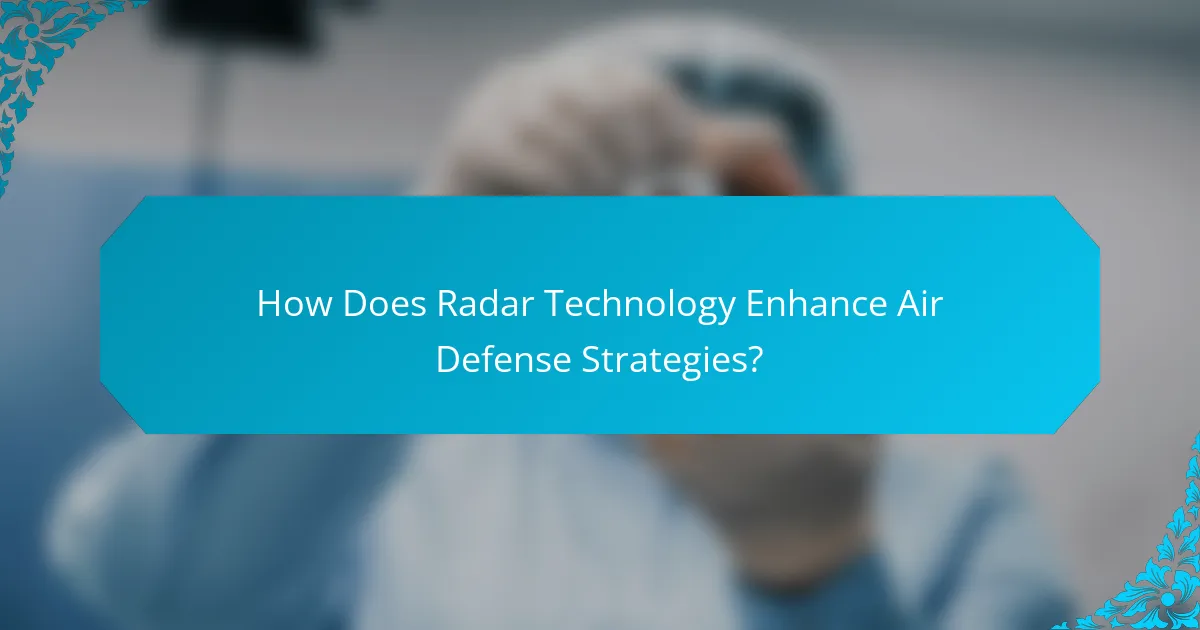Radar technology plays a pivotal role in modern air defense strategies by significantly enhancing detection, tracking, and response capabilities against aerial threats. By enabling defense systems to identify and engage targets with greater precision, radar improves overall security and operational efficiency, making it an essential component of military operations.

How Does Radar Technology Enhance Air Defense Strategies?
Radar technology significantly enhances air defense strategies by improving detection, tracking, and response capabilities against aerial threats. It allows defense systems to identify and engage targets more effectively, thereby increasing overall security and operational efficiency.
Improved target detection
Radar systems utilize radio waves to detect and identify aircraft, missiles, and other aerial threats. Modern radar can distinguish between various types of objects, significantly reducing false alarms and improving the accuracy of target identification.
Advanced radar technologies, such as phased array systems, can detect targets at greater distances and in challenging environments, including adverse weather conditions. This capability is crucial for early warning and proactive defense measures.
Real-time tracking capabilities
Real-time tracking enables air defense systems to monitor the movement of detected targets continuously. This capability allows operators to assess threat trajectories and make timely decisions regarding interception or engagement.
Systems equipped with tracking radars can update target information every few seconds, providing a dynamic view of the airspace. This constant flow of data is essential for coordinating responses among multiple defense units.
Integration with missile systems
Radar technology is integral to the operation of missile defense systems, providing the necessary targeting information for interception. By linking radar data with missile guidance systems, operators can enhance the accuracy and effectiveness of their defensive measures.
Many modern air defense systems, such as the Aegis or THAAD, rely on radar for mid-course guidance, ensuring that interceptors can adjust their flight paths in real-time to engage fast-moving threats.
Enhanced situational awareness
Radar enhances situational awareness by providing comprehensive views of the airspace, allowing defense forces to understand the operational environment better. This awareness is critical for assessing potential threats and coordinating responses among various defense assets.
With advanced radar systems, operators can track multiple targets simultaneously, gaining insights into patterns of aerial activity. This information supports strategic planning and resource allocation in air defense operations.
Data fusion with other sensors
Data fusion combines information from radar with inputs from other sensors, such as infrared and electro-optical systems, to create a more accurate picture of the airspace. This integration enhances target classification and reduces uncertainty in threat assessment.
By leveraging multiple data sources, air defense systems can improve decision-making processes and response times. This holistic approach is essential for modern defense strategies, where threats can be complex and multifaceted.

What Are the Key Types of Radar Used in Air Defense?
The key types of radar used in air defense include phased array radar, ground-based radar systems, and airborne early warning radar. Each type plays a critical role in detecting and tracking aerial threats, contributing to a comprehensive air defense strategy.
Phased array radar
Phased array radar utilizes an array of antennas that can steer beams of radio waves electronically, allowing for rapid scanning of the airspace. This technology enables simultaneous tracking of multiple targets, making it highly effective for modern air defense systems.
One significant advantage of phased array radar is its ability to maintain continuous surveillance without moving parts, which enhances reliability and reduces maintenance needs. Systems like the AN/SPY-1, used in Aegis combat systems, exemplify this technology’s capabilities.
Ground-based radar systems
Ground-based radar systems are stationary installations designed to monitor airspace from a fixed location. They typically provide long-range detection and tracking of aircraft and missiles, making them essential for national defense.
These systems can vary widely in range and capability, from short-range systems like the AN/TPS-75 to long-range systems such as the AN/FPS-117. When deploying ground-based radar, consider factors like terrain, potential interference, and integration with other defense systems to maximize effectiveness.
Airborne early warning radar
Airborne early warning radar is mounted on aircraft, providing a mobile platform for detecting and tracking threats over vast areas. This type of radar can cover blind spots that ground-based systems might miss, ensuring comprehensive situational awareness.
Examples include the E-3 Sentry AWACS, which can detect targets at hundreds of kilometers away. When utilizing airborne early warning radar, it’s crucial to maintain communication links with ground and naval forces to coordinate responses effectively and enhance overall defense strategies.

How Is Radar Technology Implemented in Military Operations?
Radar technology is crucial in military operations, providing real-time surveillance, target tracking, and threat detection. Its implementation enhances situational awareness and decision-making capabilities for air defense systems.
Deployment in conflict zones
Radar systems are deployed in conflict zones to monitor airspace and detect incoming threats, such as enemy aircraft or missiles. These systems can be mobile or stationary, depending on the operational requirements and terrain. For instance, ground-based radar can be set up quickly to cover specific areas, while airborne radar systems provide broader surveillance capabilities.
Effective deployment requires consideration of factors like terrain, weather conditions, and potential enemy countermeasures. Military planners often assess the best locations for radar placement to maximize coverage and minimize vulnerability.
Training of military personnel
Training military personnel to operate radar systems is essential for effective air defense. Operators must understand the technical aspects of radar technology, including signal interpretation and system maintenance. Regular training exercises simulate real-world scenarios, allowing personnel to practice target identification and response protocols.
Additionally, training programs often include joint exercises with allied forces to enhance interoperability and coordination. This ensures that personnel are familiar with various radar systems and can effectively collaborate in multinational operations.
Collaboration with allied forces
Collaboration with allied forces enhances the effectiveness of radar technology in military operations. Sharing radar data and intelligence can provide a comprehensive picture of the airspace, improving threat detection and response times. Joint operations often involve integrating different radar systems to create a unified defense network.
Allied forces may also engage in joint training exercises to familiarize themselves with each other’s systems and protocols. This collaboration helps to streamline communication and operational efficiency during combined missions, ensuring a cohesive air defense strategy.

What Are the Challenges of Implementing Radar Technology?
Implementing radar technology in air defense strategies presents several challenges, including high costs, vulnerability to electronic warfare, and maintenance issues. These factors can significantly impact the effectiveness and reliability of radar systems in detecting and tracking aerial threats.
High costs of advanced systems
The investment required for advanced radar systems can be substantial, often reaching millions of dollars. This includes not only the initial purchase but also ongoing expenses for upgrades, training, and support. Countries must weigh the benefits of enhanced capabilities against their budget constraints.
For example, a state-of-the-art radar system may provide superior detection ranges and accuracy, but its cost could divert funds from other critical defense areas. Decision-makers should consider cost-benefit analyses to ensure optimal allocation of resources.
Vulnerability to electronic warfare
Radar systems are susceptible to electronic warfare tactics, such as jamming and spoofing, which can compromise their effectiveness. Adversaries can deploy technologies that disrupt radar signals, rendering them less reliable during critical operations.
To mitigate these risks, military forces must invest in countermeasures and develop tactics that enhance resilience against electronic threats. Regular updates and training in electronic warfare scenarios are essential to maintain operational readiness.
Maintenance and operational issues
Maintaining radar systems can be challenging due to their complexity and the need for specialized personnel. Regular maintenance is crucial to ensure optimal performance, but it can be resource-intensive and may lead to downtime during repairs.
Additionally, operational issues can arise from environmental factors, such as weather conditions that affect radar performance. Establishing robust maintenance schedules and training programs can help address these challenges and improve system reliability.

How Do Different Countries Utilize Radar Technology?
Countries utilize radar technology in various ways to enhance their air defense strategies, focusing on detection, tracking, and targeting of aerial threats. The effectiveness of radar systems can significantly influence national security and military readiness.
United States
The United States employs advanced radar systems, such as the AN/FPS-117 and the AN/SPY-1, to monitor airspace and provide early warning of potential threats. These systems are integrated into a broader defense network that includes satellite and missile defense systems, enabling a multi-layered approach to air defense.
Additionally, the U.S. invests in research and development to improve radar capabilities, such as increasing range and resolution. This focus on innovation helps maintain a strategic advantage over potential adversaries.
Russia
Russia utilizes a variety of radar systems, including the 55Zh6ME and the Voronezh radar, to detect and track aerial targets across vast distances. These systems are often designed to operate in harsh environments, reflecting Russia’s diverse geographical challenges.
Moreover, Russia emphasizes the integration of radar with electronic warfare capabilities, allowing for sophisticated countermeasures against enemy aircraft. This dual approach enhances their overall air defense effectiveness.
China
China has rapidly advanced its radar technology, employing systems like the Type 305 and the YLC-8 to bolster its air defense capabilities. These radars are often part of an extensive network that supports both military and civilian air traffic management.
China’s focus on indigenous development has led to significant improvements in radar range and accuracy, enabling better detection of stealth aircraft. This technological growth is crucial for maintaining regional security and asserting territorial claims.
European Nations
European countries, such as France and Germany, utilize radar systems like the Thales Ground Master and the Rheinmetall TRML-4D for air defense. These systems are often integrated with NATO’s air defense initiatives, ensuring interoperability among member states.
European nations also prioritize collaborative projects to enhance radar capabilities, focusing on joint development and procurement to reduce costs and improve efficiency. This cooperation strengthens collective defense strategies across the continent.



